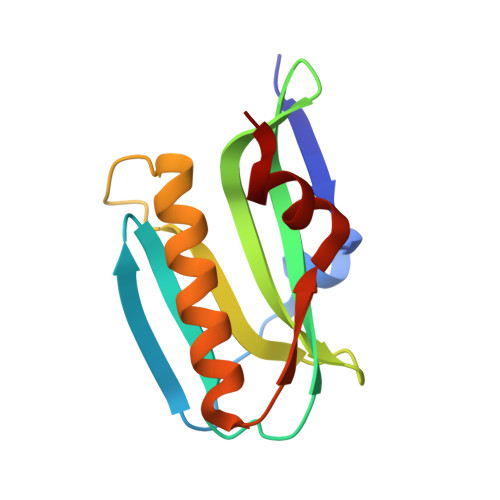Structural analyses reveal the mechanism of inhibition of influenza virus NS1 by two antiviral compounds.
Kleinpeter, A.B., Jureka, A.S., Falahat, S.M., Green, T.J., Petit, C.M.(2018) J Biol Chem 293: 14659-14668
- PubMed: 30076219
- DOI: https://doi.org/10.1074/jbc.RA118.004012
- Primary Citation of Related Structures:
6DGK - PubMed Abstract:
The influenza virus is a significant public health concern causing 250,000-500,000 deaths worldwide each year. Its ability to change quickly results in the potential for rapid generation of pandemic strains for which most individuals would have no antibody protection. This pandemic potential highlights the need for the continuous development of new drugs against influenza virus. As an essential component and well established virulence determinant, NS1 (nonstructural protein 1) of influenza virus is a highly prioritized target for the development of anti-influenza compounds. Here, we used NMR to determine that the NS1 effector domain (NS1 ED ) derived from the A/Brevig Mission/1/1918 (H1N1) strain of influenza (1918 H1N1 ) binds to two previously described anti-influenza compounds A9 (JJ3297) and A22. We then used X-ray crystallography to determine the three-dimensional structure of the 1918 H1N1 NS1 ED Furthermore, we mapped the A9/A22-binding site onto our 1918 H1N1 NS1 ED structure and determined that A9 and A22 interact with the NS1 ED in the hydrophobic pocket known to facilitate binding to the 30-kDa subunit of the cleavage and polyadenylation specificity factor (CPSF30), suggesting that the two compounds likely attenuate influenza replication by inhibiting the NS1 ED -CPSF30 interaction. Finally, our structure revealed that NS1 ED could dimerize via an interface that we termed the α 3 -α 3 dimer. Taken together, the findings presented here provide strong evidence for the mechanism of action of two anti-influenza compounds that target NS1 and contribute significant structural insights into NS1 that we hope will promote and inform the development and optimization of influenza therapies based on A9/A22.
Organizational Affiliation:
From the Departments of Biochemistry and Molecular Genetics and.














